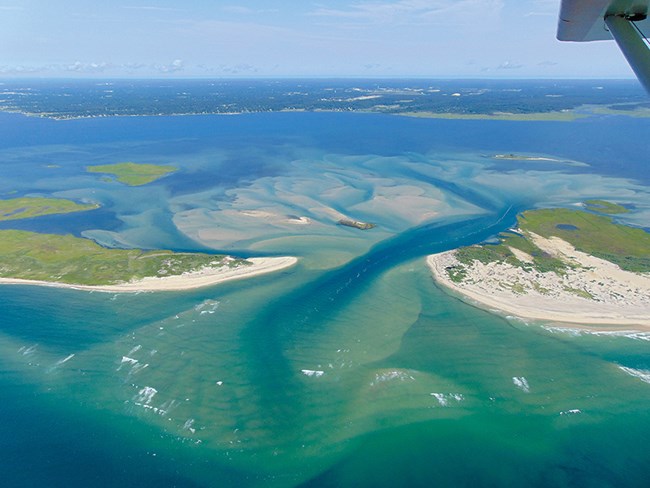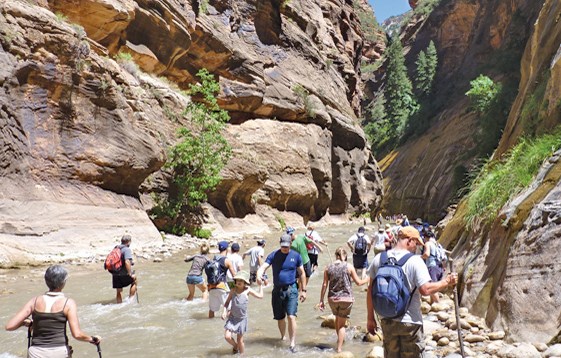Last updated: June 8, 2022
Article
The Inventory and Monitoring Conservation Initiative

NPS / Larry McAfee
Born from a Vision
Since the year 2000, the National Park Service’s inventory and monitoring (I&M) networks have been helping park managers know which natural resources are in their parks, and how they’re changing over time. The creation of 32 networks embodied a bold vision in which any National Park Service unit—regardless of size, location, or budget—would have the strong science it needed to support good decisionmaking. Today, more than 270 parks have basic natural-resource inventories. In those parks, ecologists follow strict protocols to track the condition of park “vital signs”—key resources that indicate ecosystem health and provide early warning of problems. And parks have access to a servicewide, user-friendly database of natural-resource information.Now, we set our sights on 2040. How can we leverage the foundation we’ve built to ensure parks are prepared to meet the challenges ahead? What is the next bold vision that will allow us to capitalize on our progress and propel us through the next two decades?
Shaping the Next Vision
To build that vision, we went to the source of our greatest potential: our staff. Borrowing techniques from successful businesses and non-profit organizations, we engaged in a non hierarchical visioning process facilitated by an external contractor and driven by staff from all levels of the organization: ecologists, communicators, administrative staff, data managers, and field staff, from first-year hires to career leaders nearing retirement. We started by pulling together four groups of 25–40 people from diverse locations and fields of expertise. These workshops, or “jam sessions,” gave participants the chance to draw on their experience and envision how I&M could have the greatest impact over the next 20 years.Participants worked in small groups and brought their results to the larger group, riffing off one another’s thoughts and allowing organic development of ideas. Answers emerged.

NPS / Jessica Weinberg McClosky
A separate workgroup distilled the resulting ideas into a single articulation of where the division should be in 2040:
-
Operating in a culture of shared leadership and committed partnership that facilitates exceptional science and empowers decisionmakers,
-
Bringing people together to address conservation challenges with confidence and creativity, and
-
Doing work that inspires stewardship in others and is a beacon for the preservation of nature across the globe.
In March 2020, more than 140 I&M staff assembled in Prescott, Arizona, to define the goal (below) that will allow us to realize that vision, and to map our paths toward it. By this point, fully half of all I&M employees had contributed to the process.
The Power of Alignment
The 2040 goal will be achieved through a series of smaller steps that align individual actions with collective aims. Each 90 days, staff members identify and strive to meet an individual goal that supports a group milestone leading to the 2040 goal. At the same time, staff are participating in self-selected workgroups also aligned toward reaching the milestones. Milestones are reviewed and re-established every 180 days. In this way, we will achieve the milestones and, ultimately, the 2040 goal, through cumulative individual action.
Everyone Has a Role to Play
The I&M Conservation Initiative, and its 2040 goal, are not intended to replace the I&M Division’s core purpose, mission, or goals (see below). They are intended to leverage our core successes for even broader impact. Whether we’re working across network boundaries to improve scientific methods, secure the future of our data security, build financial capacity, or strengthen our professional relationships, those efforts will help us move forward together.
I&M Conservation Initiative Goal: 2,040 for 2040
By 2040, I&M, together with its partners and parks, will generate 2,040 science-based solutions to promote resilient ecosystems.
I&M Purpose, Mission, and Goals
Purpose
The NPS Inventory & Monitoring Division advances scientific understanding to inspire stewardship of nature.
Mission
The NPS Inventory & Monitoring Division provides exceptional ecosystem science to support informed stewardship of our national parks.
Primary Goals
- Inventory
- Monitor
- Integrate I&M information into planning, management, & decision making
- Share with other natural resource organizations and form partnerships for attaining common goals and objectives
What Are Science-Based Solutions?
Since the National Park Service began inventory and monitoring activities, they have provided parks with countless solutions to management issues based on scientific analysis of data methodically collected over time.Over the next 20 years, the national parks will face unprecedented environmental changes. To adapt to these changes—and strengthen ecological resilience—parks will need exceptional science and solid partnerships. Below are some examples of science-based solutions networks have provided in the past. The I&M Conservation Initiative strives to scale up successes like these.

NPS
Monitoring data collected by the Northeast Coastal and Barrier Network before the breach were compared to extensive data collected after the breach, allowing managers to see the effects on water levels, water quality, salinity, and species richness. These data, along with additional information and expertise from multiple partners, were critical in the final analysis, which showed the breach was actually ecologically beneficial. The best solution was to allow it to remain.

NPS
The Northern Colorado Plateau Network worked with park staff; state, federal, and local agencies; and a private landowner to identify the bacterial source and implement solutions.
Today, water quality appears to be improving. In results from monthly sampling, the number of E. coli exceedances has been decreasing since 2012.

NPS / Seth Hendricks
Then, after a two-year drought, none were observed at monitoring locations. Park staff joined the Heartland Network and other partners to start supplemental sampling in water bodies throughout the park. A large population of Topeka shiners was found in a pond.
This exciting news prompted further collaboration to develop a plan to reestablish shiners in the streams using this pond population. In the fall of 2019, Topeka shiners were relocated into previously inhabited stream sites. Monitoring of the reintroduced populations, coupled with continued fish community monitoring, is now the best hope for improving Topeka shiner numbers in the park.

NPS / Alexandria Warneke
Join Us!
Reaching our goal of 2,040 science-based solutions by 2040 will take teamwork. If you are part of I&M, reach out to your colleagues to pitch in where your talents will make a difference. Based in a park? Talk to your network staff and help us develop science-based solutions for your park. New to I&M? Not sure what we’re all about or who to contact? Learn more about us, our staff, how we got started, and where we’re headed.
-
Visit the Inventory and Monitoring Division website to find information on staff, monitoring, reports, and results
- Read the Harvard Business Review article that inspired our planning process
- Check the interative map below with links to each Inventory and Monitoring network
Contact Us
National Park Service Inventory and Monitoring Division
1201 Oakridge Drive
Ft. Collins, Colorado 80525






